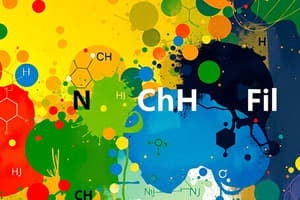Podcast
Questions and Answers
What is the correct name for the compound Fe₂O₃?
What is the correct name for the compound Fe₂O₃?
Which of the following is named correctly as a molecular compound?
Which of the following is named correctly as a molecular compound?
What distinguishes alkynes from alkenes in organic compound nomenclature?
What distinguishes alkynes from alkenes in organic compound nomenclature?
Which of the following represents a correct binary acid?
Which of the following represents a correct binary acid?
Signup and view all the answers
What prefix would be used for the molecular compound with the formula C₆H₁₄?
What prefix would be used for the molecular compound with the formula C₆H₁₄?
Signup and view all the answers
Which of the following statements about ionic compounds is true?
Which of the following statements about ionic compounds is true?
Signup and view all the answers
What is the correct name for the ionic compound MgCl₂?
What is the correct name for the ionic compound MgCl₂?
Signup and view all the answers
In the nomenclature of molecular compounds, what is the correct suffix for the second element?
In the nomenclature of molecular compounds, what is the correct suffix for the second element?
Signup and view all the answers
Flashcards
Ionic Compounds
Ionic Compounds
Ionic compounds are formed by the electrostatic attraction between positively charged cations and negatively charged anions.
Naming Ionic Compounds
Naming Ionic Compounds
The name of the cation is written first, followed by the name of the anion.
Naming Cations and Anions
Naming Cations and Anions
Metal cations are named using the element's name. Nonmetal anions are named by changing the ending of the element name to '-ide'.
Molecular Compounds
Molecular Compounds
Signup and view all the flashcards
Naming Molecular Compounds
Naming Molecular Compounds
Signup and view all the flashcards
Alkanes
Alkanes
Signup and view all the flashcards
Alkenes
Alkenes
Signup and view all the flashcards
Alkynes
Alkynes
Signup and view all the flashcards
Study Notes
Ionic Compound Nomenclature
- Ionic compounds are formed by the electrostatic attraction between positively charged cations and negatively charged anions.
- The name of the cation is written first, followed by the name of the anion.
- Metal cations are named using the element's name.
- Nonmetal anions are named by changing the ending of the element name to "-ide."
- Examples: NaCl (sodium chloride), MgO (magnesium oxide), KBr (potassium bromide)
- Transition metals often have multiple possible charges, so Roman numerals are used to indicate the charge.
- Examples: FeCl₂ (iron(II) chloride), FeCl₃ (iron(III) chloride)
Molecular Compound Nomenclature
- Molecular compounds are formed by the sharing of electrons between nonmetal atoms.
- The first element in the formula is named first, and the second is named using the -ide suffix.
- Prefixes are used to indicate the number of atoms of each element.
- Prefixes: mono, di, tri, tetra, penta, hexa, hepta, octa, nona, deca.
- Examples: CO (carbon monoxide), CO₂ (carbon dioxide), N₂O₄ (dinitrogen tetroxide), PCl₅ (phosphorus pentachloride).
- Note: the prefix "mono" is often omitted for the first element.
Organic Compound Nomenclature
- Organic compounds primarily contain carbon and hydrogen, but may also contain other elements.
- Hydrocarbons are compounds that contain only carbon and hydrogen.
- Alkanes: Simplest hydrocarbons, contain only single bonds between carbon atoms. Named using the prefix that indicates the number of carbon atoms in the chain followed by the suffix -ane. (e.g., methane, ethane, propane...).
- Alkenes contain at least one carbon-carbon double bond. Named using the prefix indicating carbon number followed by the suffix -ene. (e.g., ethene, propene...).
- Alkynes contain at least one carbon-carbon triple bond. Named following a similar pattern but using the suffix -yne. (e.g., ethyne, propyne).
- Other functional groups (e.g., alcohols, aldehydes, ketones, carboxylic acids, esters) affect the naming.
- Structural isomerism: Different arrangement of the atoms in a molecule results in different properties and names for the isomers.
Acid Nomenclature
- Acids are substances whose molecules release hydrogen ions (H⁺).
- Arrhenius concept defines an acid as a substance that increases the concentration of H+ ions in aqueous solutions.
- Binary acids: contain hydrogen and one other nonmetal. Named generally as "hydro-" plus the stem of the nonmetal name plus "-ic acid". (e.g., HCl is hydrochloric acid).
- Oxyacids: contain hydrogen, oxygen, and one other nonmetal.
- Naming depends on the anion.
- If the anion ends in -ate, the acid ends in -ic acid (e.g., H₂SO₄ sulfuric acid).
- If the anion ends in -ite, the acid ends in -ous acid (e.g., HNO₂ nitrous acid).
Studying That Suits You
Use AI to generate personalized quizzes and flashcards to suit your learning preferences.
Description
Explore the rules for naming ionic and molecular compounds in chemistry. This quiz covers how to correctly identify cations, anions, and the significance of Roman numerals for transition metals. Test your knowledge with examples and learn the application of prefixes in molecular nomenclature.




